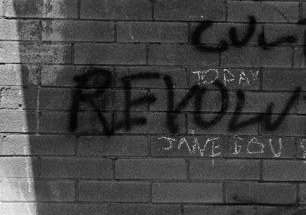BILLBOARD PROJECT WITH TANYA HARNETT FOR OCICIWAN: “Urban Spaces” installed in Edmonton

“Urban Spaces” by Tanya Harnett & Jeff Thomas (www.ociciwan.com)
Another billboard project in 2016 was with artist Tanya Harnett. The billboard was installed from August 18 to October 2nd at 101 St North of 105 Ave, east side of the street, facing South. The project was curated by Ociciwan, in partnership with AKA Artist Run in Saskatoon, also a partner in The Dancing Grounds billboard project.
Urban Spaces is a collaborative photographic installation between Tanya Harnett and Jeff Thomas. The project is curated by Ociciwan, in partnership with AKA Artist Run in Saskatoon. The billboard installation is meant to create dialogue with passers-by, reaching out to those who do not typically enter the traditional gallery space. Thomas’ photograph provokes questions surrounding Indigenous culture, challenging perceptions of Indigenous and non-Indigenous ideology. Harnett created a custom jacket referencing both a straitjacket and an item of traditional Indigenous clothing that engages a double reading of constriction and the idea of an Indigenous presence and ceremony through its fringes. The location of the billboard in Edmonton acts as a type of marker or gateway between class divided neighbourhoods by providing unique imagery highlighting the complexities of urban Indigenous experience.
Thomas and Harnett’s collaboration focus on life as an urban-based Indigenous person, and the constraints and beauty associated with contemporary urban existence. Building on years of a professional relationship, Harnett created the fringed straightjacket expressing her silent frustration, which she then sent to Thomas to incorporate into his photographic practice. After careful consideration, Thomas chose to photograph the Harnett’s piece in front of a graffiti wall in Ottawa, a site of personal significance to Thomas that also provided a vibrant backdrop for the image. In creating this image, Thomas and Harnett seek to make visible the invisible and accessible to dialogue and contemplation. The resulting work sits at an invisible boundary, the intersection between a civic centre and neighborhoods that are on the periphery of communities perceived as socially and economically vulnerable. (Read more…)



